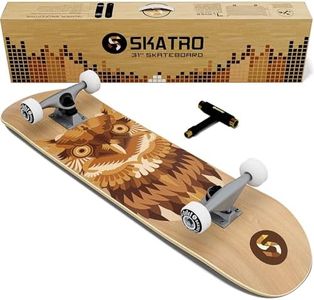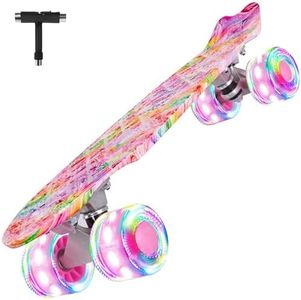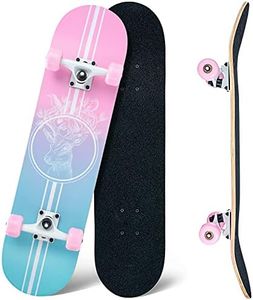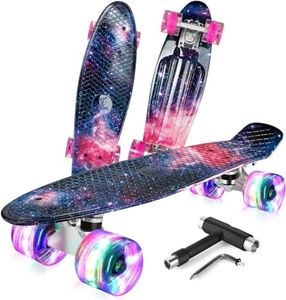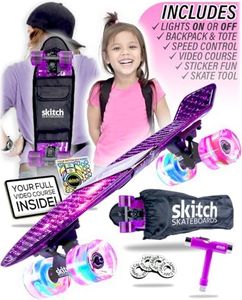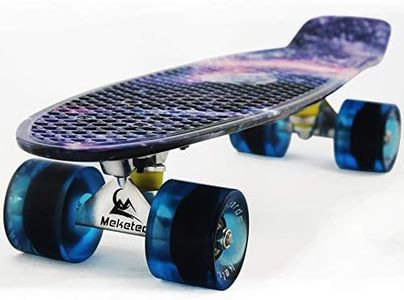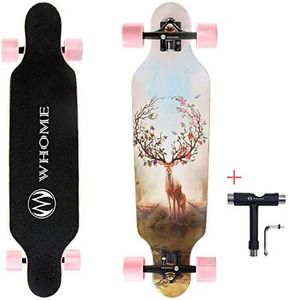We Use CookiesWe use cookies to enhance the security, performance,
functionality and for analytical and promotional activities. By continuing to browse this site you
are agreeing to our privacy policy
10 Best skateboards for beginners
From leading brands and best sellers available on the web.Buying Guide for the Best skateboards for beginners
When choosing a skateboard as a beginner, it's important to focus on finding a board that supports your learning and helps you develop confidence. Beginners should prioritize stability, ease of control, and comfort over flashy designs or advanced features. Understanding key specifications will help you pick a skateboard that matches your skill level and skating goals.Deck WidthThe deck width refers to how wide the skateboard is from side to side. This is a crucial factor for beginners because a wider deck generally offers more stability, making it easier to balance and learn basic moves. Skinnier decks are lighter and easier to flip, but they can feel less stable for those just starting out. Decks typically range from about 7.5 to 8.5 inches wide. For most beginners, a width around 8 inches is a sweet spot, as it provides a good balance between stability and maneuverability.
Deck LengthDeck length means how long the skateboard is from tip to tail. Longer decks offer more space for your feet, which can make learning to balance easier. Short decks are more responsive and suited for tricks but may feel cramped at first. For beginners, a standard length, which is about 28 to 33 inches, gives you enough room without making the board too difficult to control.
Deck MaterialMost skateboard decks are made from layers of maple wood, but you might also find boards made from bamboo or composite materials. Maple is durable, stiff, and widely used, making it a good choice for beginners. Bamboo boards are lighter and can be a bit more flexible. For most new skaters, a maple deck will provide the sturdiness and pop needed to start learning basic skills.
TrucksTrucks are the metal parts that attach the wheels to the deck, and they play a big role in how your skateboard turns and feels. The width of your trucks should closely match the width of your deck to provide better stability. Low trucks are closer to the ground and good for flips, while higher trucks give more clearance for larger wheels and smoothing out rough surfaces. Beginners should look for standard trucks that fit their deck width for better balance and easier turning.
WheelsSkateboard wheels come in different sizes and hardness levels. Larger wheels (about 54mm to 60mm) roll over cracks more smoothly, which is ideal if you're skating outdoors. Smaller wheels (about 50mm to 53mm) are lighter and good for technical tricks but can be bumpy on rough surfaces. For hardness, softer wheels (around 78A to 87A) grip better and are smoother, while harder wheels (over 99A) are fast but can be slippery. Beginners generally benefit from mid-sized, softer wheels for a comfortable and controlled ride.
Grip TapeGrip tape is the rough, sandpaper-like material on top of the deck that helps your shoes grip the board. All skateboards will have it, but some tapes are coarser or finer than others. A standard, medium-coarse grip tape works well for most beginners, providing enough hold without being too harsh on your shoes or hands during practice.
Shape and ConcaveThe shape of the board, especially the curve in the deck called 'concave', affects foot placement and control. A steeper concave makes it easier to do tricks, while a flatter board is more comfortable for cruising and beginners. Most beginners should pick a deck with a mild to moderate concave for a welcoming feel and easier learning curve.
